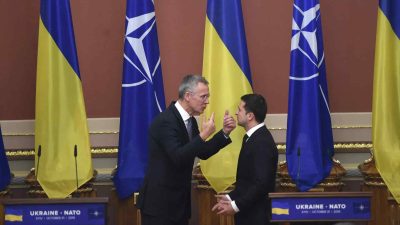Stoltenberg Bluffs About Ukrainian NATO Access

All Global Research articles can be read in 51 languages by activating the Translate Website button below the author’s name.
To receive Global Research’s Daily Newsletter (selected articles), click here.
Click the share button above to email/forward this article to your friends and colleagues. Follow us on Instagram and Twitter and subscribe to our Telegram Channel. Feel free to repost and share widely Global Research articles.
***
Discussions about Ukraine’s possible entry into NATO still seem far from over. Now, NATO’s top official has stated that Kiev is close to gaining its long-awaited access, which is surprising given that Zelensky was publicly ignored during the bloc’s last summit.
The words were spoken by the head of the alliance, Jens Stoltenberg, on September 7, during a meeting with members of the European Parliament. During his speech, he emphasized that the military bloc “shares the same values [and] the same challenges” with Ukraine, in addition to commenting on recent progress towards Kiev’s integration with the alliance.
“We reiterated that Ukraine will become a member of NATO, but then we added three elements which actually move them closer to membership (…) And these three things, the interoperability, the NATO-Ukraine Council and removal of the requirement for Membership Action Plan for Ukraine, demonstrates that Ukraine has never been closer to a membership in NATO than now”, he said. (emphasis added)
Recalling the Vilnius summit, Stoltenberg stated that, despite not having received a precise “roadmap” on its path to accession, Kiev was promised that some steps would be advanced in the process. The steps established were the increase in military interoperability, the creation of an official representation council for Ukraine within NATO and the process simplification, with the possibility of skipping some bureaucratic requirements that must be accomplished by other candidates. Considering that these measures have already been implemented, Stoltenberg believes that Kiev is closer to membership now than ever before.
However, Stoltenberg did not give any “roadmap” for Kiev in his latest speech either. He only said that fulfilling the three promises makes access “closer” now than it was before but did not state what will happen next in this process. No announcement was made about new discussions on the admission, with the speech being limited to simply saying that it is “close”, without concrete evidence to corroborate this conclusion.
In practice, the words sound like a mere bluff. To date, there has been no significant progress in the process and NATO does not seem interested in moving this agenda forward. However, to keep the alliance’s public image positive and avoid criticism from Kiev and the mainstream media, Stoltenberg recalls the membership pledge and tries to give new “hope” to the proxy state. The aim is to make Ukraine and its supporters, as well as Western public opinion, believe that access will actually happen, even if all evidence suggests that the project is being “frozen”.
The refusal to accept Ukraine into the alliance is the correct attitude to be taken, as the country is currently in a situation of open conflict. Considering NATO’s collective defense norms, the entry of the Kiev regime would mean the immediate start of an open global conflict. It is known that Kiev is fighting for NATO on the battlefield, obeying orders from Western leaders and working as a proxy. However, the neo-Nazi regime’s participation in the alliance’s war plans will certainly remain limited to this proxy role.
NATO wants war with Russia, but does not want to risk losing its troops in a direct confrontation with no chance of victory. For the alliance, it is more interesting to maintain a proxy war, trying to “wear down” Russia in the long term without causing so much direct damage to Western countries. Evidence of NATO’s lack of interest in a direct war can be seen in the fact that the alliance ignored Ukrainian false flag allegations about “Russian attacks” against Poland and Romania, for example. If NATO wanted a direct conflict with Russia, it would certainly adopt the Ukrainian narrative – but this is not in the West’s plans, at least for now.
Western countries know that in order to prevent the process of geopolitical transition to multipolarity it will be necessary to simultaneously neutralize Russia and China. It is impossible to win a war with both powers at the same time, so the bet is on maintaining proxy conflicts with Russia and launching an anti-Chinese military campaign in the future. In this sense, the current conflict in Ukraine must be seen as just one part of NATO’s real anti-Russian strategy.
There is nothing so “special” in Kiev to legitimize Western intervention in its favor. The military aid given by NATO is not motivated by “common values” or “defense of democracy”, as the propaganda says. It is just a way to indirectly prolong the conflict with Russia. For the West, the Ukrainians are just “cannon fodder” in this scenario. It is a shocking reality, but Ukraine agreed to participate in this war plan a long time ago, when it chose to align with the West in 2014.
So, unless new factors emerge in the near future indicating some real progress for Ukrainian membership, Stoltenberg’s words are seen as a simple bluff, as Kiev’s access does not appear to be in NATO’s interests.
*
Note to readers: Please click the share button above. Follow us on Instagram and Twitter and subscribe to our Telegram Channel. Feel free to repost and share widely Global Research articles.
Lucas Leiroz is a journalist, researcher at the Center for Geostrategic Studies, geopolitical consultant. You can follow Lucas on Twitter and Telegram.
Featured image is from InfoBrics

